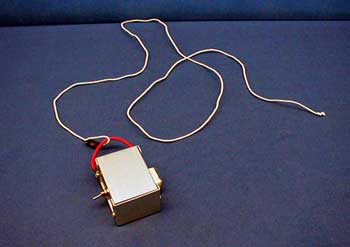Demos: 4C-01 Doppler Effect

A loud tone generator is attached to a long cord and whirled in a near-horizontal circle. At one point on the circular path, the source is moving directly toward the listener. At the diametrically opposite point, the source is moving away from the listener. The pitch alternately rises and falls as the source is whirled, illustrating the Doppler effect.
Directions: Turn on the tone generator by inserting the plug into the receptacle. Then start whirling the device over your head in a horizontal circle. (It is really loud, so don’t spend too much time on this!)
NOTE: You, as the demonstrator, will not hear the Doppler effect. Why? Because the source is moving at all times perpendicular to a line connecting you with the source.
Suggestions for Presentation: After discussing the Doppler effect, ask what conditions must met regarding the relative motion between the source and listener. (If the two are moving directly toward or away from each other, the standard equations apply. If they move at some angle to each other, there is cosine component involved such that if the source is moving at right angles to the listener, there is no apparent change in frequency.) Ask the students what these conditions are at the various points in the circular path and what will that will do to the perceived frequencies.
Based on this information, ask why a car horn doesn’t jump discontinuously from one frequency to another as the car passes by. (It would if it passed directly through you, but then you wouldn’t hear the second half!!)
Applications: Car horns and railroad whistles at relative velocities.
Last Updated: Nov 30, 2023 11:25 AM